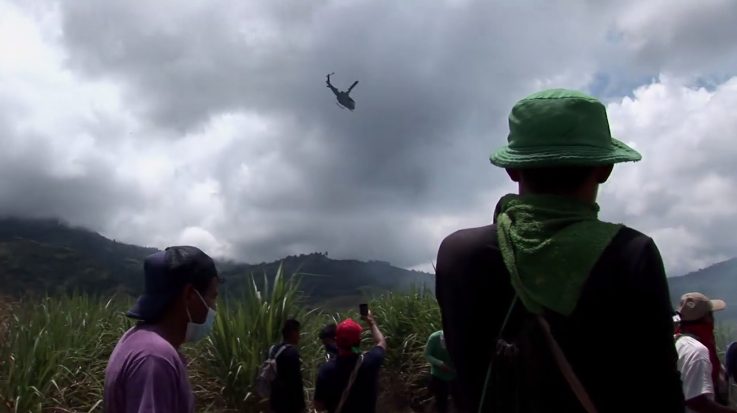
by DGR News Service | Jul 30, 2019 | Direct Action, Reclamation & Expropriation
Editor’s note: DGR is not affiliated with the Secret Forest Society (Sociedade Secreta Silvestre) and does not endorse their statements or actions. This article is only for informational purposes. Some content in this article was sourced from the Rio Times Online.
by Liam Campbell
Jair Bolsonaro, Brazil’s openly fascist President, is loathed by groups who care about preventing climate collapse and protecting the Earth’s last healthy ecosystems. According to the Guardian, Bolsonaro’s policies are now resulting in 3 football fields per minute of rainforest destruction, and scientists fear that the Amazon is reaching a critical tipping point, beyond which it will be impossible to save. If that “point of no return” is breached it will result in massive forest fires, which will release an immense amount of sequested CO2 into the atmosphere, accelerating climate collapse and annihilating one of the Earth’s sources of oxygen. Violence is also increasing and loggers have begun killing indigenous leaders and resistors from the over 400 tribes who call the forest home. Bolsonaro has overseen major funding cuts and firings at the Brazilian indigenous affair agency, which has gutted the few remaining governmental protections for these people.
Presumably this is why the Secret Forest Society (Sociedade Secreta Silvestre) have now targeted Bolsonaro for assassination. Two weeks ago, Veja Magazine interviewed one of the leaders of the Secret Forest Society (SSS), a branch of an international organization called the Individuals Tending Toward the Wild (ITS). The leader, identified as Anhangá, claimed that Bolsonaro was supposed to be executed on the day of his inauguration, but they were temporarily foiled by an unexpected security presence. Since then Bolsonaro has cancelled several key events, including an open car parade. Anhangá stated “We could easily blend in and carry out this attack, but the risk was enormous (…), so it would be suicidal. We didn’t want that.”
It is unclear how or when the Secret Forest Society plans to assassinate Jair Bolsonaro, but their affiliates in the ITS have been linked to letter bombs, University explosions, and the successful assassination of a biotechnology researcher. Their organization claims to stand up against people and systems that lead to environmental destruction, and they advocate for using extreme measures against nature’s enemies.
An excerpt from the book Deep Green Resistance: Strategy to Save the Planet, Chapter 13: “Tactics and Targets.”
This leads us to the last major underground tactic: assassination.
In talking about assassination (or any attack on humans) in the context of resistance, two key questions must be asked. First, is the act strategically beneficial, that is, would assassination further the strategy of the group? Second, is the act morally just, given the person in question? (The issue of justice is necessarily particular to the target; it’s assumed that the broader strategy incorporates aims to increase justice.)
As is shown on my two-by-two grid of all combinations (see Figure 13-3), an assassination may be strategic and just, it may be strategic and unjust, it may be unstrategic but just, or it may be both unstrategic and unjust. Obviously, any action in the last category would be out of the question. Any action in the strategic and just category could be a good bet for an armed resistance movement. The other two categories are where things get complex.
Hitler exemplified a number of different strategy vs. justice combinations at different points in time. It’s a common moral quandary to ask whether it would be a good idea to go back in time and kill Hitler as a child, provided time travel were possible. There’s a good bet that this would have averted World War II and the Holocaust, which would have been a good thing, so put a check mark in the “strategic” column. The problem is that most people would consider it unjust to murder an innocent child who had yet to commit any crimes, so it would be difficult to call that action just in the immediate sense.
Once Hitler had risen to power in the late 1930s, though, his aim was clear, as he had already been whipping up hate and expanding his control of Nazi Germany. At that point, it would have been both strategic and just to assassinate him. Indeed, elements in the Wehrmacht (army) and the Abwehr (intelligence) considered it, because they knew what Hitler was planning to do. Unfortunately, they were indecisive, and did not commit to the plan. Hitler soon began invading Germany’s neighbors, and as his popularity soared, the assassination plan was shelved. It was years before inside elements would actually stage an assassination attempt.
That famous attempt took place—and failed—on July 20, 1944.
What’s interesting is that the Allies were also considering an attempt on Hitler’s life, which they called Operation Foxley. They knew that Hitler routinely went on walks alone in a remote area, and devised a plan to parachute in two operatives dressed as German officers, one of them a sniper, who would lay in wait and assassinate Hitler when he walked by. The plan was never enacted because of internal controversy. Many in the SOE and British government believed that Hitler was a poor strategist, a maniac whose overreach would be his downfall. If he were assassinated, they believed, his replacement (likely Himmler) would be a more competent leader, and this would draw out the war and increase Allied losses. In the opinion of the Allies it was unquestionably just to kill Hitler, but no longer strategically beneficial (Figure 13-4).
There is no shortage of situations where assassination would have been just, but of questionable strategic value. Resistance groups pondering assassination have many questions to ask themselves in deciding whether they are being strategic or not. What is the value of this potential target to the enemy? Is this an exceptional person or does his or her influence come from his or her role in the organization? Who would replace this person, and would that person be better or worse for the struggle? Will it make any difference on an organizational scale or is the potential target simply an interchangeable cog? Uniquely valuable individuals make uniquely valuable targets for assassination by resistance groups.
Of course, in a military context (and this overlaps with attacks on troops), snipers routinely target officers over enlisted soldiers. In theory, officers or enlisted soldiers are standardized and replaceable, but, in practice, officers constitute more valuable targets. There’s a difference between theoretical and practical equivalence; there might be other officers to replace an assassinated one, but the replacement might not arrive in a timely manner nor would he have the experience of his predecessor (experience being a key reason that Michael Collins assassinated intelligence officers). That said, snipers don’t just target officers. Snipers target any enemy soldiers available, because war is essentially about destroying the other side’s ability to wage war.
The benefits must also outweigh costs or side effects. Resistance members may be captured or killed in the attempt. Assassination also provokes a major response—and major reprisals—because it is a direct attack on those in power. When SS boss Reinhard Heydrich (“the butcher of Prague”) was assassinated in 1942, the Nazis massacred more than 1,000 Czech people in response. In Canada, martial law (via the War Measures Act) has only ever been declared three times—during WWI and WWII, and again after the assassination of the Quebec Vice Premier of Quebec by the Front de Libération du Québec. Remember, aboveground allies may bear the brunt of reprisals for assassinations, and those reprisals can range from martial law and police crackdowns to mass arrests or even executions.
There’s an important distinction to be made between assassination as an ideological tactic versus as a military tactic. As a military tactic, employed by countless snipers in the history of war, assassination decisively weakens the adversary by killing people with important experience or talents, weakening the entire organization. Assassination as an ideological tactic—attacking or killing prominent figures because of ideological disagreements—almost always goes sour, and quickly. There are few more effective ways to create martyrs and trigger cycles of violence without actually accomplishing anything decisive. The assassination of Michael Collins, for example, by his former allies led only to bloody civil war.
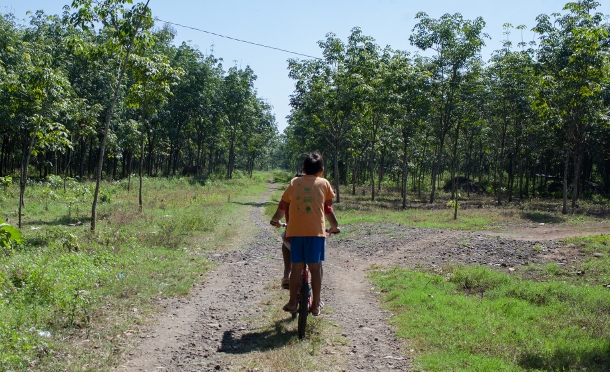
by Deep Green Resistance News Service | Jun 7, 2018 | NEWS, Reclamation & Expropriation
Featured image: Two children ride a bike through the plantation known as Las Palmeras in Guatemala. (WNV/Jeff Abbott)
by Jeff Abbott / Waging Nonviolence
Guatemala’s southern coast is in a constant conflict caused by the expansion of agro-industry. Across the region, small farmers struggle to feed their families as companies buy up more and more land for export crops.
Since the arrival of the Spanish to Guatemala in 1524, the country’s fertile southern coast has been the site of some of the most intense social conflicts over land. These conflicts have continued into the 21st century with the massive expansion of sugar cane and palm oil production.
Many of these land holdings have come to include illicit interests, including drug trafficking. But local small farmers, known as campesinos, have pushed back.
Since September 2016, 135 families associated with the Committee for Campesino Unity, also known by its Spanish acronym CUC, have maintained an occupation of a finca, or a large plantation, named Las Palmeras near the municipality of Cuyotenango. They are calling for the state to expropriate the land, which was once owned by a known drug trafficker, to the campesinos.
“We see the necessity [in our communities],” said Marcos (a pseudonym), a resident of the community of Progreso, who is supporting the occupation. “We have no place to work the land due to the amount of monoculture that surround us. They have made themselves the owners of the land. We have taken this finca because we need the land to sow the basic crops.”
The campesinos come from the surrounding departments of Quetzaltenango, Suchitepequez, and Retalhuleu.
The farmers have set up a small settlement on the finca, building small structures, as well as using the houses that are on the finca. They have established a collective store in the center of the finca, where they sell sodas, cooking oil and other common household items.
Since taking the finca, the campesinos have also begun to divide the land among the families. Many families have spent nearly two years sowing and harvesting several seasons of crops, including maize, beans, peanuts and fruits.
“They accuse us of land invasion,” said Francisco (a pseudonym), a campesino from a neighboring town who is supporting the occupation. “This is not an invasion, but rather a recuperation the lands of our ancestors.”
Organizing the occupations
Occupations have long been used in Guatemala by campesinos to gain titles to land. That practice grew dramatically in the 1950s following the passage of land reform under President Jacobo Arbenz. His administration expropriated unused land from large land holders, including the U.S.-based United Fruit Company, to be distributed among landless farmers across the country. After the U.S.-backed coup d’état in 1954, however, the tactic fell out of practice due to the threat of violence.
According to research by Charles D. Brockett, occupations would return to prominence in the late 1970s with the formation of the CUC. The organization was founded during the Guatemalan internal armed conflict and worked for the interests of the small farmers across Guatemala, as well as against structural inequalities and racism.
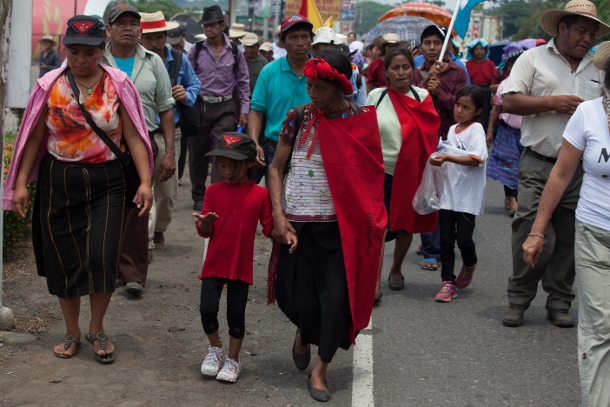
A woman wears a CUC flag while holding the hand of her daughter who wears a CUC hat during the 2016 water march. (WNV/Jeff Abbott)
Since the beginning of the 21st century, the region has seen the massive expansion of monocrops, such as sugar cane and bananas, for export by large landholders. This expansion of export crops further exacerbated the land crisis on the coast, driving many campesinos on the coast to organize to occupy the land due to the inequalities in land availability.
“The problem is that there is a lot of African palm oil, sugar cane, rubber and bananas being planted on the coast,” Marcos said. “These monocrops are leaving us without land to support our families. It was the necessity that drove us to take the finca. [The large land owners] have left us without any land.”
But the support from the CUC has been the key for the occupation on the Guatemalan coast, with the organization providing moral and legal support for the campesinos in Suchitepequez.
“After we launched the occupation, the CUC arrived to provide support,” Francisco said. “The CUC has worked for years to serve and support campesinos across Guatemala.”
The campesinos have also received support from other farmers who have participated in other occupations in the country. They sent others to support the occupation when it began.
“We had a meeting a few days [before the occupation] with other campesinos [that had participated in occupations],” Francisco said. “They saw the necessity of launching the occupation of the land. They decided on the date, where everyone came at 4 p.m. to occupy the land.”
Guatemala has a land problem that has dictated social relations from the Spanish invasion until today. A small percentage of the population controls the majority of arable lands that they utilize for the production of export crops for foreign markets such as sugar cane, African palm oil and bananas. This problem is being exacerbated by the rise of the influence of drug traffickers and criminal networks in the two decades since the end of the internal armed conflict in 1996.
Following the signing of the peace accords, the Guatemalan government established the Land Fund, which was meant to resolve the historic land problem. Yet the high price of the land often keeps it out of reach of landless farmers.
Narcos and land
Drug traffickers have increasingly taken to purchasing land as a means of laundering money, and as a means of transporting narcotics through Central America. As the country continues to work to fight drug trafficking in the country, campesinos have increasingly taken to occupying lands owned by convicted and accused drug traffickers, as well as lands owned by their associates.
The case of Finca Palmeras is a good example of this.
The finca was founded when the Ralda family purchased extensive land holdings in the department of Suchitepequez. Prior to the establishment of the finca, the land was largely used for rice production and cattle ranching.
When Manuel Ralda died, he divided the farm among his children, but his children chose to sell the land, including Finca Palmeras. In 1995, the lands of Finca Palmeras were transferred into the national land registry. Campesinos and others lined up to purchase the lands, but the price was outside the range made available by the Land Fund. The owners of the nine caballerias of land (or a little more than 850 acres) were set at 1.5 million quetzales per caballeria, or a little over 205,000 dollars.
“A group of campesinos entered that wanted to purchase the finca,” Francisco said. “But at the time, the Land Fund only provided credit for 1 million quetzales per caballeria. The fund would not provide the money to buy the land.”
Then entered Juan Alberto Ortiz Lopez — commonly known as Juan Chamale — who was one of the principal drug traffickers in Guatemala, and the main connection to the Mexican Sinaloa Cartel. He offered to buy the finca for 3 million quetzales per caballeria, and purchased the property. His goal was to create a front company to hide the transit of drugs from Colombia through the coastal region.
He quickly put in place security to block the local residents from passing through the finca to access the nearby Icán river, which was a popular fishing spot.
“Before we could fish in the rivers without any problem,” Francisco said. “But when Jaun Charmale bought the finca he put in place security guards, and it was prohibited to pass through the finca.”
According to the neighbors and campesinos occupying the finca, Charmale built new routes through the finca in order to move drugs. These routes connected to other fincas, eventually arriving at the Mexican border.
During the time that Ortiz Lopez owned the finca he would rent the lands to the neighboring fincas. This has caused problems for the campesinos occupying the land.
Furthermore, the campesino communities face an uphill battle to gain access to the land. The campesinos have faced intimidation and repression from the nearby fincas, including legal action over their occupation.
“We found ourselves with a problem,” Francisco said. “The neighboring fincas had sugar cane on part of the finca, and they filed a lawsuit against us in order to harvest that years’ crop.”
These lawsuits have included orders for the arrest of the organizers. The farmers also faced an eviction order that the police to date have not carried out.
Ortiz Lopez was finally arrested in 2011 on drug trafficking charges, and eventually extradited to the United States in 2014. At the time of his arrest, he was in possession of eight or nine fincas across Guatemala, which he would rent out to sugarcane producers, especially the nearby finca Palo Gordo. He had used the fincas as a means to launder his money from trafficking.
“The end of [Alvaro] Colom’s administration was when he finally fell,” Francisco said. “The government began to take the cattle that he had on the land.”
The campesinos are emboldened through the Law of Extinction of Domain, which was established in 2010. The law permits the expropriation of any assets of anyone convicted of a crime related to narco-trafficking, or any illicit crime.
Yet the campesinos’ claim is complicated. By the time he was arrested, Ortiz Lopez had put the titles for his land in his youngest son’s name. But campesinos from the region have laid claim to the lands, arguing that the Guatemalan government must apply the law, and expropriate the farm and distribute it among the small farmers.
Violence against occupying farmers
Despite the constant threat of eviction, the community has yet to see any violence. Meanwhile, other communities that have utilized the same law to argue for expropriating land have not been so lucky.
On October 30, 2017, the residents of the Q’eqchi’ Maya community of Chaab’il Ch’och were violently evicted from the homes they had occupied for a year. Police and military burned houses and crops, as well as the belongings of residents.
The community of Chaab’il Ch’och sits on a finca called Santa Isabel located in the municipality of Livingston, Ixabal. The finca was acquired by a shell company owned by former President Otto Pérez Molina.
The finca is currently being administered by Rodrigo Lainfiesta, a businessman and ally of Pérez Molina, who is also facing corruption charges. Pérez Molina is currently being prosecuted for corruption, as well as charges related to his association with drug traffickers.
In an interview for Upside Down World, one member of the occupation stated that they believed the land was used or going to be used for drug trafficking.
Yet, in spite of the violence against other communities, the campesinos in Suchitipequez are confident that they will emerge victorious.
“We are asking God that we will win, and believe we will,” Francisco said. “For our children, we do not want to see any more malnutrition in our communities.”
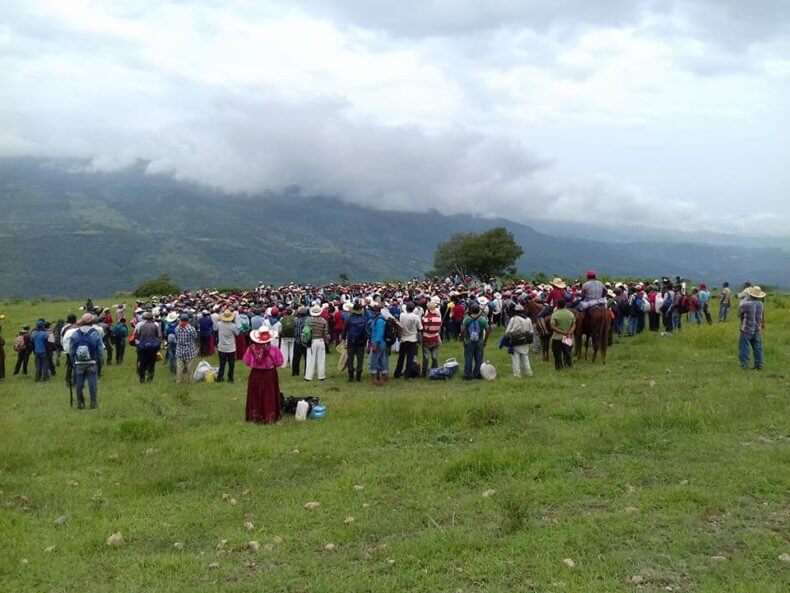
by Deep Green Resistance News Service | Sep 26, 2017 | Reclamation & Expropriation
Featured image by Octaviano Díaz Chema
by Tracy Barnett / Intercontinental Cry
HUAJIMIC, Nayarit, Mexico — A century-old land conflict has flared up again in the Western Sierra Madre, deepening already raw tensions in the wake of the May 2017 assassination of two Huichol (Wixárika) leaders who fought to reclaim that land.
On Friday, the anniversary of last year’s equally contentious reclamation action, 1,200 indigenous Huichols hiked for three hours down a mountain into the contested valley of Huajimic to meet the court officials scheduled to sign over to them a bitterly contested piece of farmland.
The officials never arrived, however, because ranchers opposing the restitution staged a roadblock, and police never showed up to enforce the action. Now the Huichols say they’ll stay put on the remote piece of farmland until the restitution is complete, setting the stage for a potentially violent standoff of uncertain duration.

Photo: Octaviano Díaz Chema
Friday’s restitution was to be the second in a series of legal procedures recognizing the wrongful possession of 10,500 hectares (nearly 26,000 acres) of Huichol land by the region’s mestizo ranchers more than 100 years ago.
The ranchers hold titles from the Mexican government dated around 1906, but the Huichol people hold land grants dating back to the 1700s from the Spanish crown.
Since last year’s hard-fought restitution, the leader of that effort, Miguel Vázquez Torres, was shot to death by a truck full of armed gunmen, as was his brother Agustin. Many suspect they were targeted because of their outspoken support of the land restitution.
On Sept. 22, 2016, after a series of lawsuits were decided in favor of the Huichol community of San Sebastián Teponohuaxtlán, they moved in to claim their first parcel, a 184-hectare (454-acre) hillside ranch about 5 miles from the ranching town of Huajimic. That action was followed with a roadblock and threats of violence. Since that time three Huichol families moved in to set up a homestead and begin farming, and faced repeated threats from residents of the nearby town of Huajimic.
This time, the contested tract is only 63.7 hectares (157 acres), but for the Huichol community, it represents the leading edge of their fight to reclaim their ancestral homelands. For the ranchers, it represents the line they must hold to prevent the dispossession of lands that have been in their families for generations.
The day before the scheduled restitution, local and state officials met in the Nayarit state capital of Tepic with Agrarian Tribunal Magistrate Aldo Saúl Muñoz López and assured him that public security forces would be present to prevent violence, said Cristián Chávez, a territorial expert representing the Huichol community of San Sebastian, who was present at the meeting and the subsequent roadblock.
The promised police forces never showed up, and a caravan including various court officials, a state human rights observer, attorneys and media representatives made their way through the hilly terrain, driving for more than an hour before confronting the roadblock. Several pickup trucks blocked the road and about 40 individuals were on the scene, said Chávez.
Magistrate Muñoz López got down from his truck and informed the ranchers that he was there to carry out an order from the court, and politely asked them to let the caravan pass, according to a report by Agustín del Castillo from Milenionewspaper. Ranchers flatly denied passage.
Given that there was no law enforcement present, Muñoz López drew up a document describing the circumstances that prevented the execution of justice, and expressed his intention to seek the means to follow through with the legal decision as soon as possible, said Chávez. He also reassured the ranchers that he would take their concerns to the authorities in the state and federal government.
Carlos González was visibly upset with the circumstances, according to del Castillo’s report. “We blame the governor of Nayarit, Antonio Echavarría, his secretary general of government and his attorney general, for the violence that could be caused by this situation, since 1,200 comuneros have come down to the property and taken possession of it, and given the traffic and food blockades on the part of the ranchers, the situation may become unsustainable,” he said with obvious annoyance.
The Mexican government has come under severe criticism for its lack of action in the case, rejecting repeated requests by Huichol leaders and ranchers alike to reimburse ranchers with federal funds designated to help prevent land conflicts.
The spokesman for Mexico’s Secretariat of Agrarian, Territorial and Urban Development, which is charged with resolving land disputes, said the agency lacks the resources to get involved and is already faced with more than 300 pending land conflicts.
Huichol representatives have taken their case directly to the public in videos posted on Facebook Saturday. They say they will continue to occupy the land until the court officials arrive and formalize the restitution. In one of them, a camera pans a massive crowd standing in a field, with mountains in the backdrop. Felipe Serio Chino, president of the community’s security council, steps forward.
“Today, Sept. 22, 2017, more than 1,000 comuneros (Huichol community members) gathered here in this place to demand of Magistrate Aldo Raul Muñoz López, who is in charge of Tribunal 56 in Tepic, Nayarit, that he deliver this land into our possession as it was programmed. All these comuneros are awaiting your presence. Without it, we will stay until we achieve the objective we came here for.
“We send a salute to Mr. Aldo but we also ask him not to be a coward, to not be afraid, to not allow anyone to prevent him from doing his duty… the law has recognized it; we are only demanding what is ours.”
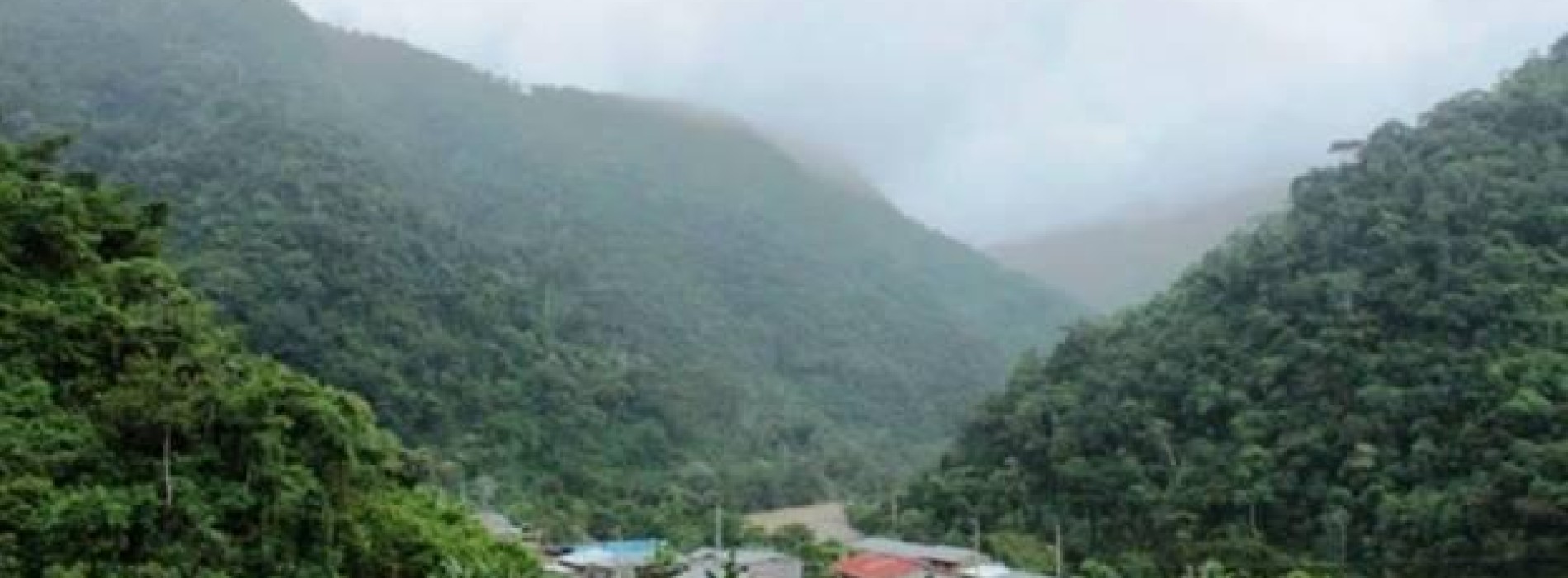
by Deep Green Resistance News Service | Jul 25, 2017 | Reclamation & Expropriation
by Autonomous Territorial Government of the Wampís Nation / via Intercontinental Cry
Translated by Daniel Dayley
After more than half a year from the commitment of the national authorities to execute a third interdiction operation at the illegal mining site established in the Pastacillo stream basin, tributary of the Santiago and Marañón River, in the Amazon region [of Peru], The Autonomous Territorial Government of the Wampís Nation (GTANW), in view of the breach of this commitment, agreed and decided to peacefully evict the illegal miners from that area.
The operation was carried out on July 13, in coordination with the Municipal District of Santiago, and included the participation of approximately 200 members of the wampís communities near the Villa Gonzalo community.
They arrived at the mining establishment in the morning and the workers were peacefully asked to leave the area. At that point the only dredging machine there was confiscated and destroyed. In the afternoon, in Puerto Galilea, a group of people from the community of Yutupis, made up mostly of indigenous Awajun and who are divided because of members who profit from illegal mining, attacked the wampis who had participated in the operation against the illegal mining. A total of four wampís men were wounded in the confrontation.
At the moment, we Wampís are developing collective meetings in order to reach agreements and to take new actions in the future that deal with the onslaught of illegal miners. At the same time, we are demanding the presence of the National Police of Peru in the area to avoid a recurrence of violent episodes on the part of those who work in and benefit from illegal mining.
It should be mentioned that the decision of the action was also communicated in a timely way to the main relevant authorities, such as the PCM (Fernando Zavala), the Ministry of the Interior, the Ministry of Defense, the Ministry of Energy and Mines, the District Attorny’s office specializing in Bagua’s environmental issues, and the PNP of Santa María de Nieva; and requesting of them the necessary support and guarantees.
Through this press release we reiterate our commitment to the defense, protection and preservation of our territories, forests and biodiversity; and we urge the authorities of the Peruvian State to intervene and provide the necessary guarantees for the lives of the indigenous peoples who watch over, protect and fight for humanity’s right to a good life.
Puerto Galilea, July 14, 2017.
Autonomous Territorial Government of the Wampís Nation
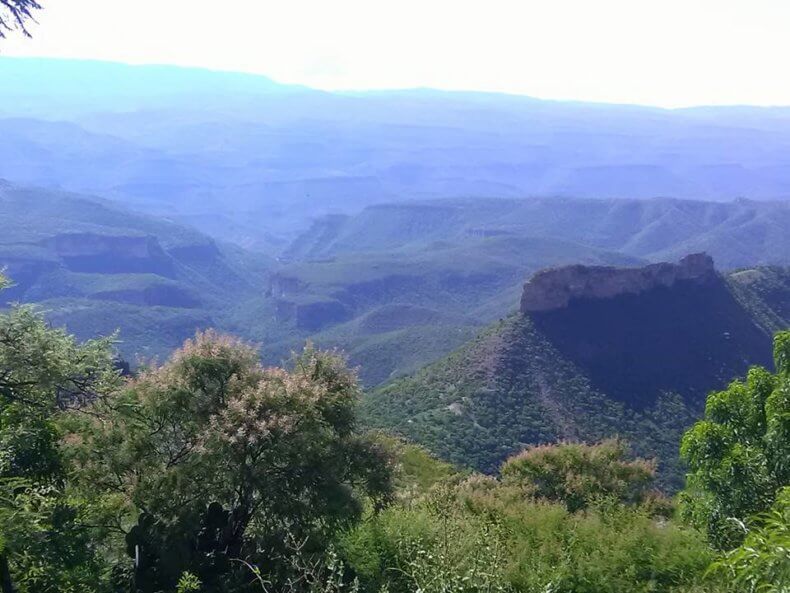
by Deep Green Resistance News Service | Sep 21, 2016 | Indigenous Autonomy, Reclamation & Expropriation
Featured image: The Wixárika community of San Sebastian Teponahuaxtlán or Wuaut+a is preparing to send 1,000 members to the remote Nayarit community of Huajimic to take back from the ranchers lands that the courts have ruled belong to the Wixárika. Photo from Facebook/San Sebastian Teponahuaxtlán.
by Tracy Barnett / Intercontinental Cry
A contingent of at least 1,000 indigenous Wixárika (Huichol) people in the Western Sierra Madre are gearing up to take back their lands after a legal decision in a decade-long land dispute with neighboring ranchers who have held the land for more than a century.
Ranchers who have been in possession of the 10,000 hectares in question for generations say the seizure is unlawful and that they will not hand over the land — setting the scene for a showdown that observers fear may end in violence.
Leaders of the Wixárika community of San Sebastian Teponahuaxtlán have announced their plans to accompany the authorities of the federal agricultural tribunal to carry out an enforcement action on the first parcel, a 184-hectare ranch in the state of Nayarit, on Sept. 22, and called on state and federal law enforcement officials to send police forces to prevent a conflict. Until the time of publication, neither the Nayarit nor the federal authorities had agreed to send police to maintain order, so both parties are hoping for the best but preparing for the worst.
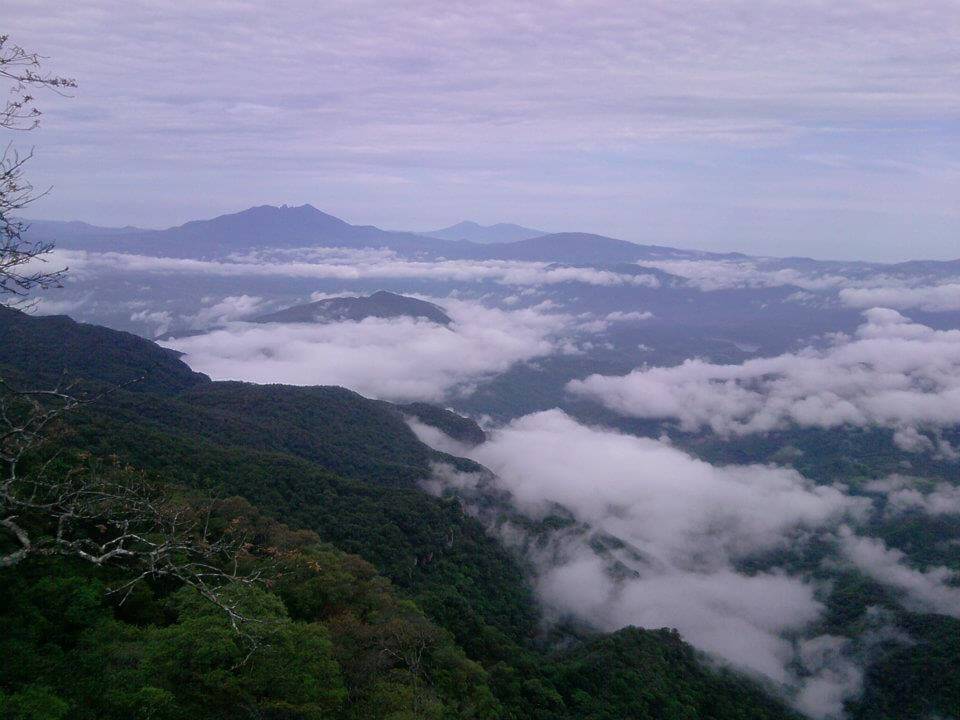
The Nayarit community of Huajimic in the municipality of La Yesca has a long tradition of ranching. Ranchers of Huajimic have titles to their land that date to 1906, but the courts have ruled that the Wixarika land claims go back to the Spanish land grant of 1717. Photo from Facebook/Huajmic, Nayarit.
“We’re hoping they’ll accept the decision which is now law: that they lost the trial. They had the opportunity to legally prove that they really had the documentation and they didn’t have it,” said Miguel Vázquez Torres, president of the communal lands commission of San Sebastian. He is aware of the potential for violence, he said, “but the community is not going to sit with its hands crossed. We are prepared.”
Ranchers have titles to the land that go back to the early 1900s — but San Sebastian has the original grant from the Spanish crown that dates to 1717, and is backed by a 1953 presidential resolution. In all, 10,000 hectares is at stake, for a total of 47 different claims. The agrarian court has ruled in favor of San Sebastian in 13 of those cases; the remainder are still in process.
Rosa Carmen Dominguez Macarty, an attorney representing some of the ranchers of Huajimic, disputes the version presented by Wixarika attorneys, saying that only two of the sentences are definitive, and that all the rest are still under appeal. The ranchers are appealing the 1953 presidential resolution, saying it is based on a document that is invalid.
“It’s a social injustice,” she said. “These are very simple people; they are fathers, they are mothers who work the land themselves, and that’s how they support their families. It would be really sad if through the government’s disregard, something unpleasant were to happen.”
Vázquez said that two families who have no land have already been granted permission by the community assembly to establish homesteads on the parcel and that the assembly plans to send a rotating contingent of community residents to stand guard for several months — “as long as it’s necessary so that the families can feel safe and comfortable.” The long-term plan, he said, is to establish another settlement in the area, as San Sebastian’s existing towns are becoming overcrowded.
Dominguez argued that the local inhabitants have worked the land for generations and turned it into a highly productive area. Local residents suspect the Huicholes have another ulterior motive for taking back the land, which they have never worked: to exploit the mineral deposits that supposedly lie beneath.

Members of the Wixarika community of San Sebastian Teponahuaxtlán protesting for land reform in Guadalajara in 2014. Photo from the Facebook/San Sebastian(Wuaut+a).
Complicating matters is that San Sebastian lies in the state of Jalisco, while the contested land lies in Nayarit, where the ranchers have been outspoken in their opposition to the court decision and have been organizing in resistance to the return of the land to the Wixárika.
“Jalisco vs. Nayarit: Blood will run,” screamed one headline in a Nayarit newspaper. Meanwhile, Nayarit Gov. Roberto Sandoval reportedly has sent messages of support to ranchers.
“The governor promised us that while he is in office, we would not have to turn over a single meter of land to the Huichols,” one of the landowners told local reporter Agustín Del Castillo of Milenio newspaper.
Indeed, it’s no accident that the conflict crosses state lines, according to anthropologist Paul Liffman, author of the book Huichol Territory and the Mexican Nation.
“In fact that’s the deep history of Jalisco and Nayarit,” Liffman said in a recent interview. “Nayarit was part of Jalisco, and it separated in 1917, in part for the ranchers who wanted more political autonomy and also wanted to kick out the Indians.”
During the early years of the 20th century, the government encouraged settlers to make land claims on apparently abandoned land. It was during that period that major encroachment began to occur on Wixárika land, and the courts granted titles based on the erroneous assumption (or pretext, as Liffman says) that the land was unoccupied.
Tensions have flared periodically since the land was taken but the Wixárika had no legal recourse until the government created an agrarian court system in the 1990s, said Ruben Avila Tena, the attorney representing the community of San Sebastian. Soon afterwards that community began a legal process of reclaiming its land.
Jalisco law enforcement has agreed to be present, but only up to the state line; thus far the Wixárika leadership has received no such assurances from the Nayarit authorities, nor from the federal government.
“I’m not sure what the Jalisco police can do, besides cheering them on from the other side of the border,” commented Avila Tena. “It’s actually a very worrisome situation.”
Avila said sources in the Agrarian Tribunal have told them that the Nayarit police have no intention of supporting the Wixárika on Sept. 22. Agrarian Magistrate Aldo Saul Muñoz López spoke to this reporter by telephone but said he could not grant an interview by telephone, only in person in the Tribunal regional offices in Tepic, Nayarit.
“We did what corresponds to us as a federal tribunal, we notified all of the relevant authorities of Nayarit. If they don’t respond, it’s something that escapes my authority,” said Muñoz López, but would not give further information by phone.
Liffman likened the current conflict in San Sebastian with one that arose in the 1950s under the Huichol leader Pedro de Haro. Haro built a movement that ultimately procured the 1953 presidential resolution confirming that San Sebastian was the legal owner of the land. But as in the present case, the government didn’t provide any enforcement mechanism, and the local residents refused to give up the land. A band of armed Huichols took the matter into their own hands and marched to the Canyon of Camotlán, where they reportedly burned down a farm, drove out local residents and reclaimed the land.

Photo from the Facebook pages of the community of San Sebastian (Wuaut+a).
Santos de la Cruz Carrillo, a Wixárika leader and also an attorney on San Sebastian’s legal team, said the community has been urging the federal authorities to attend to this case for five years under a program that would offer financial compensation to the current landholders.
“It’s been five years since the community of San Sebastian asked the federal government to attend to this situation, to support the landholders with compensation”, said de la Cruz. “But the ranchers showed no interest in the compensation; they always said they want the land, so the community chose to take possession.”
Finally, in a meeting in March of this year, an official with that program told San Sebastian authorities that there was no money to pay restitution to the ranchers. That’s when they made the decision to move ahead with the process of retaking the lands, said Avila.
The Wixárika authorities have done everything in their power to seek compensation for the ranchers in the hope that a conflict could be avoided, said Avila. “This case was decided in their favor more than two years ago,” he stressed. “The community didn’t want it to be enforced like this, they were trying to get the federal government to indemnify the landholders. When they couldn’t do that anymore, they said, it can’t be helped, we will have to ask the tribunal to enforce the law.”
Liffman warned that the situation was not to be taken lightly; the area has changed radically since the times of Pedro de Haro, he said, with a significant amount of drug production now occurring throughout the territory.
“The region has become much more heavily armed,” he said. “San Sebastian has been the most violently disputed area in the sierra over the past several years…. it’s big-scale transnational narcos now, it’s not just some ranchers with pistols on their belts. So if it does come to that, it could be a bloodbath.”









